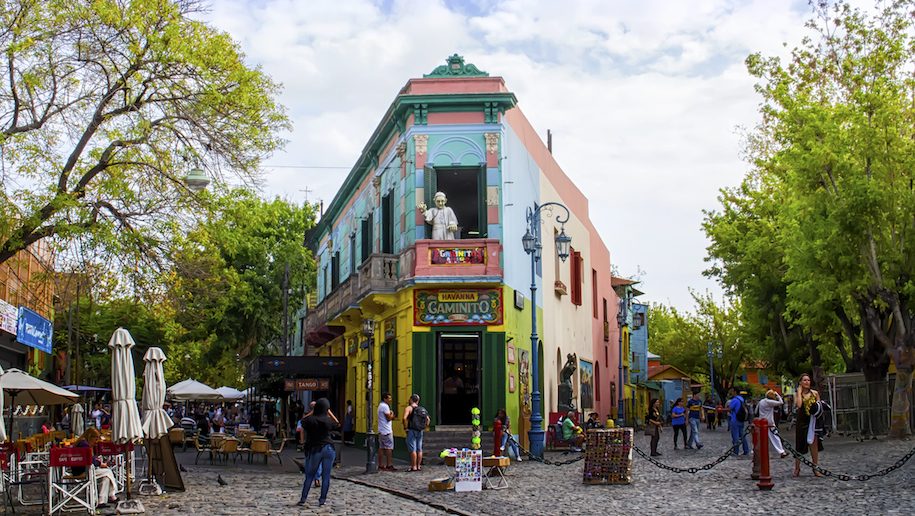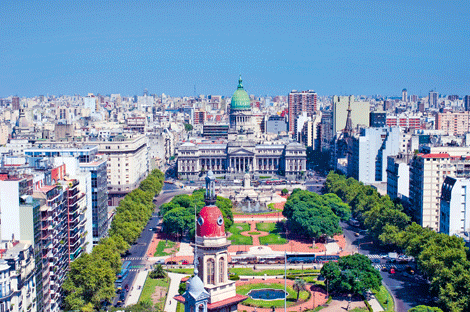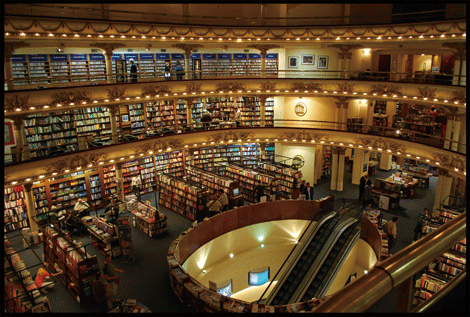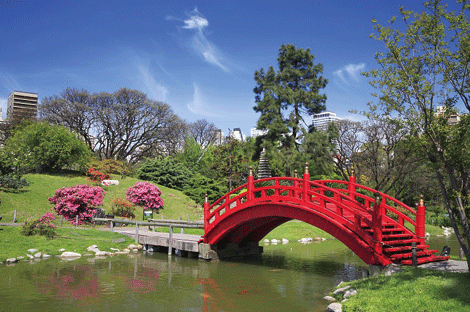
A decade has passed since Argentina suffered the worst economic collapse in over a century. The global financial crisis at the end of 2008 paled in comparison to the seismic economic quake that hit Argentina in December 2001. The beleaguered country saw five presidents come and go within a 10-day period, the population suffer the loss of life savings as the peso devalued dramatically – US$20 billion disappearing overnight – followed by the country making history with the largest ever sovereign debt default of more than US$80 billion.
However, Argentina staged a swift and steady recovery and has triumphed over adversity to become a success story. The Argentine economy has grown 94 per cent for the years 2002-2011 with last year’s growth rate recorded at 9.2 per cent. Tourism is booming and with many new air links, it’s more convenient to visit than ever before. The capital Buenos Aires is a grand city in every sense; steeped in history and gloriously rich in culture, it offers visitors such a wealth of opportunity it could induce choice paralysis.
One way to mine the city’s deep cultural seam is to eschew the obvious tourist haunts listed in guidebooks and let the city’s most acclaimed intellectual luminary be your guide.
Of Argentina’s numerous authors and literary figures none is more emblematic of Buenos Aires than Jorge Luis Borges. A revered figure in 20th century literature, Borges is the quintessential “man of letters”, a master of the short story, novel, poem and essay.
Why not go beneath the surface of the city and delve into its fascinating literary heritage by visiting the places distinguished by the exalted scholar?

Calle Florida
Borges lived for many years on Calle Florida, the pedestrianised street at the heart of business and commerce in the city. Filled with shopping arcades, offices, restaurants, tango dancers and street performers, it’s an essential stop for tourists and business travellers alike. Respite from the frenetic pace can be found by visiting the Centro Cultural Borges. This cultural centre is one of the most respected in the capital with a consistent reputation for running engaging art exhibitions and theatre productions. Most exhibits are temporary but there is also a permanent space dedicated to Borges that displays texts, drawings, photographs and poems, providing insight into the many distinct periods of his life.
Near to the centre Borges used to meet with his avant-garde literary group in a café on Calle Florida. The duly named “Florida Group” were famed for “embracing art for art’s sake” and regularly met at the Richmond café – once frequented by numerous great writers and celebrities and regarded as an institution in itself. Borges was also known to have used the Richmond to edit his famous literary magazine, Martin Fierro.
El Ateneo
Before leaving Calle Florida, a trip to the original El Ateneo bookstore at number 340 is essential. It’s an alluring shop that is much loved in the area and obviously stocks an abundance of Borges. However, be sure to leave some time and money for visiting the second branch of El Ateneo at 1860 Avenida Santa Fe. This world-renowned bookshop is a must-see, literary-inspired excursion or not. Housed in a former theatre, the appropriately named Grand Splendid, the cavernous space with its preserved box seats and opulent display of books is a paradise for the book lover. Borges would have approved – despite being blind for the last 30 years of his life, Borges poignantly said, “I have always imagined that paradise will be some kind of library.”

The National Library
Borges worked with books his entire life and claimed to be unable to sleep unless surrounded by them. He worked firstly in the Buenos Aires Municipal Library and one of his most famous short stories, The Library of Babel, was inspired by the never-ending process of cataloguing. Borges worked at the library for nine years; he was fired in 1941 by the Peronist government but returned years later to assume the highest possible position of director from 1955 to 1973 in the classically styled and colonnaded National Library building in the San Telmo district. Shortly after being appointed director, Borges was forced to refrain from reading due to encroaching blindness. With great strength of character he remarked upon “God’s splendid irony in granting me at once 800,000 books and darkness”.
Since 1992, the National Library has been housed in the well-heeled neighbourhood of Recoleta in a huge, modernist structure designed in 1961 by Clorindo Testa in the Brutalist style. It is the largest library in Argentina and one of the most important in the Americas. Walking around the library’s sprawling halls you can sense the weight of words supporting the thick concrete walls.
Palermo
In the leafy and bohemian neighbourhood of Palermo, which pulsates with students and sophisticates, pause briefly at Serrano 2135 – Borges’ childhood home. Continue from here leisurely exploring this photogenic neighbourhood of low-rise colonial-style villas, bustling with bars, restaurants, cafés and fashionable stores. Once a residential area for Italian immigrants, Palermo is now a hugely popular area with commensurately high real-estate prices. Borges first began to write poetry here and referred to the popular local square Plaza Serrano as the Mythical Foundation of Buenos Aires in the poem of the same name. His initial writing focused lovingly on the city and his first book of poetry was titled Fervor de Buenos Aires or Passion for Buenos Aires and was published in 1923. Borges continued to write about Argentine culture throughout his life, with notable essays such as the “History of the Tango” and “The Argentine Writer and Tradition”.

It would be easy to spend weeks, months or longer in Palermo and it’s not hard to see why Borges loved it. Another of his favourite places in the “barrio” was the Bosque de Palermo or Palermo Woods. An easy 20-minute walk or a short bus ride will bring you to a vast green expanse which contains the planetarium, the Japanese, botanical and zoological gardens, the museum of Borges’ friend, surrealist painter Xul Solar, and the impeccably maintained rose garden which inspired several Borges poems.
Hotel Bauen
To conclude the tour and enjoy a well-earned rest head for the famous Hotel Bauen at the prime location of 360 Callao Avenue. In 1982, just four years before his death, Borges gave four highly publicised conferences in the auditorium here about time, conjecture, poetry and death. A remark before his own death once more revealed his enduring love for books. “When writers die they become books, which is, after all, not too bad an incarnation.”
The Hotel Bauen has found fame in recent years as a “recuperated business”. The hotel was closed following the 2001 crisis but former workers formed a
cooperative and moved in to restore and reopen the hotel in 2003. The hotel now has over 200 restored rooms, a streetfront café and boasts healthy profits. Whilst the official ownership remains ambiguous, the hotel is nonetheless a thriving cultural hot spot that stages plays and concerts and is popular with guests interested in post-crisis Argentina.
Other points of interest
Plaza de Mayo
Buenos Aires’ main square is the perfect place to get your bearings. Palm trees, fountains and high-flying flags are all bordered by 19th century government buildings, while in the centre is the Piramide de Mayo monument consecrating Argentina’s 1810 independence revolution. Surrounding it, in a perfect circle, white scarves are painted on the ground. They are a memorial to the unionists, Marxists and students who died or went missing during the military intervention of 1976-83 (a figure that swings unnervingly between 9,000 and 30,000), as well as a testimony to the scarf-wearing mothers and grandmothers who march here every Thursday in remembrance. The spot in front of Casa Rosada, where President Juan Peron welcomed his supporters’ adulation with wife Eva, is these days used for demonstrations.
Recoleta Cemetery
The best way to get around the city quickly is by car, so flag down a taxi (they’re cheap) and head to Recoleta and its sprawling 1820s cemetery, 10 minutes away from Plaza de Mayo. Shaded by towering, spiky-branched palo borracho trees and blossoming lilac jacarandas, the maze of mausoleums – from art-deco black marble giants to Renaissance-style structures covered in ghostly cherubs – is worth a visit. If time is short, bypass the queues by Eva Peron’s relatively low-key marker, as well as the graves of former presidents, generals, writer Jose Hernandez and Nobel Peace Prize winner Carlos Saavedra Lamas, for some lesser-known souls’ resting places. The neo-Gothic memorial for Liliana Crociati de Szaszak is impossible to pass. The young bride was honeymooning in Austria when she was killed in an avalanche in 1970 and her tomb, a melancholic figure of a woman clothed in a simple wedding dress, is haunting.
Algodon Mansion
Pass the blindingly white Iglesia del Pilar flanking the cemetery’s entrance – one of the city’s oldest churches, built in 1732 – and walk down leafy Avenida Presidente Manuel Quintana, turning right at Montevideo. Recoleta is typified by its grand Belle Epoque architecture and Algodon Mansion hotel, at number 1,647, is a great example. The 1912
white-fronted townhouse was restored in 2010 to become the city’s first Relais and Châteaux property. It has a traditional Cognac bar if you only have time for a tipple, but if you can stretch to a meal, try the superb food at Chez Nous restaurant. Chef Antonio Soriano creates regional specialities using French techniques – the gravlax salmon (85 pesos/US$18) comes with organic flowers, manchego cream cheese and toasted almonds, and the ribeye (149 pesos/US$32) is grilled over quebracho red wood. The glass-covered patio is a great spot for a glass of Argentine red. Open Sun-Wed 7am-12am, Thurs-Sat 7am-1am; tel +54 11 3530 7777; www.algodonmansion.com
Lo de Joaquin Alberdi
To sample the country’s best-known exports head to 1772 Jorge Luis Borges for this discreet shop that sells some of the finest wines Argentina produces. With vintages stacked high on shelves covering every wall, it’s a little like entering an old-world bookshop where the vendor – in this case, senor Alberdi – has his favourite volumes and spends all day dusting off and rediscovering rare finds. Spontaneous wine tastings are not unknown, with enthusiastic sommelier-trained staff encouraging browsers to get stuck in, but if you have time, you can also request a tasting session in the back room (call ahead to arrange – it costs 80 pesos/US$17 for about 30 minutes, although session length can be tailored). For beginners, the staff will give an overview of the regions – from high-altitude Salta in the north, where the torrontes grape produces excellent cabernet sauvignon, to icy Patagonia in the south, with its crisp rieslings and, most famous of all, the violet malbecs produced in the foothills of the Andes. It’s just a shame you won’t be able to carry them in your hand luggage. Tel +54 11 4832 5329; www.lodejoaquinalberdi.com
Liat Clark








